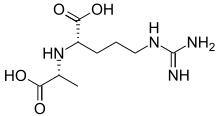Octopine
Octopine is a derivative of the amino acids arginine and alanine. It was the first member of the class of chemical compounds known as opines to be discovered. Octopine gets its name from Octopus octopodia from which it was first isolated in 1927.[1]
 | |
| Names | |
|---|---|
| IUPAC name
2-[[1-Carboxyethyl]amino]-5-(diaminomethylideneamino)pentanoic acid | |
| Identifiers | |
| |
3D model (JSmol) |
|
| 3DMet | |
| ChEBI | |
| ChemSpider | |
| KEGG | |
| MeSH | octopine |
PubChem CID |
|
| |
| |
| Properties | |
| C9H18N4O4 | |
| Molar mass | 246.267 g·mol−1 |
| Related compounds | |
Related alkanoic acids |
|
Related compounds |
|
Except where otherwise noted, data are given for materials in their standard state (at 25 °C [77 °F], 100 kPa). | |
| Infobox references | |
Octopine has been isolated from the muscle tissue of invertebrates such as octopus, Pecten maximus and Sipunculus nudus where it functions as an analog of lactic acid.[2] It is also produced by Agrobacterium and causes crown gall tumor growth in plants.[3]
Octopine is formed by reductive condensation of pyruvic acid and arginine through the action of the NADH-dependent enzyme octopine dehydrogenase (ODH).[4] The reaction is reversible so that pyruvic acid and arginine can be regenerated.
References
- Morizawa, Kiyoshi (1927). "The extractive substances in Octopus octopodia". Acta Scholae Medicinalis Universitatis Imperialis in Kioto. 9: 285–298.
- Hockachka, P.; Hartline, P.; Fields, J. (1977). "Octopine as an end product of anaerobic glycolysis in the chambered nautilus". Science. 195 (4273): 72–4. doi:10.1126/science.831256. PMID 831256.
- Lippincott, James A.; Lippincott, Barbara B. (1970). "Lysopine and octopine promote crown-gall tumor growth in vivo". Science. 170 (3954): 176–177. doi:10.1126/science.170.3954.176. PMID 17833501.
- Smits, Sander H.J.; Mueller, Andre; Schmitt, Lutz; Grieshaber, Manfred K. (2008). "A Structural Basis for Substrate Selectivity and Stereoselectivity in Octopine Dehydrogenase from Pecten maximus". Journal of Molecular Biology. 381 (1): 200–11. doi:10.1016/j.jmb.2008.06.003. PMID 18599075.
This article is issued from Wikipedia. The text is licensed under Creative Commons - Attribution - Sharealike. Additional terms may apply for the media files.
